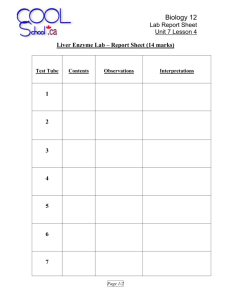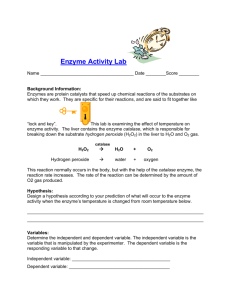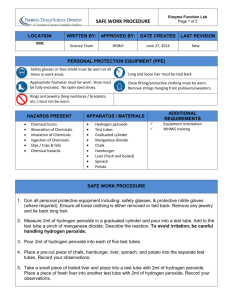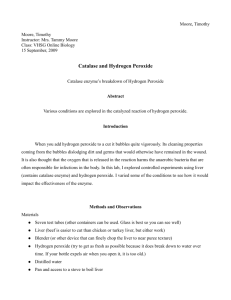Lab 3-2: Enzyme Activity
advertisement
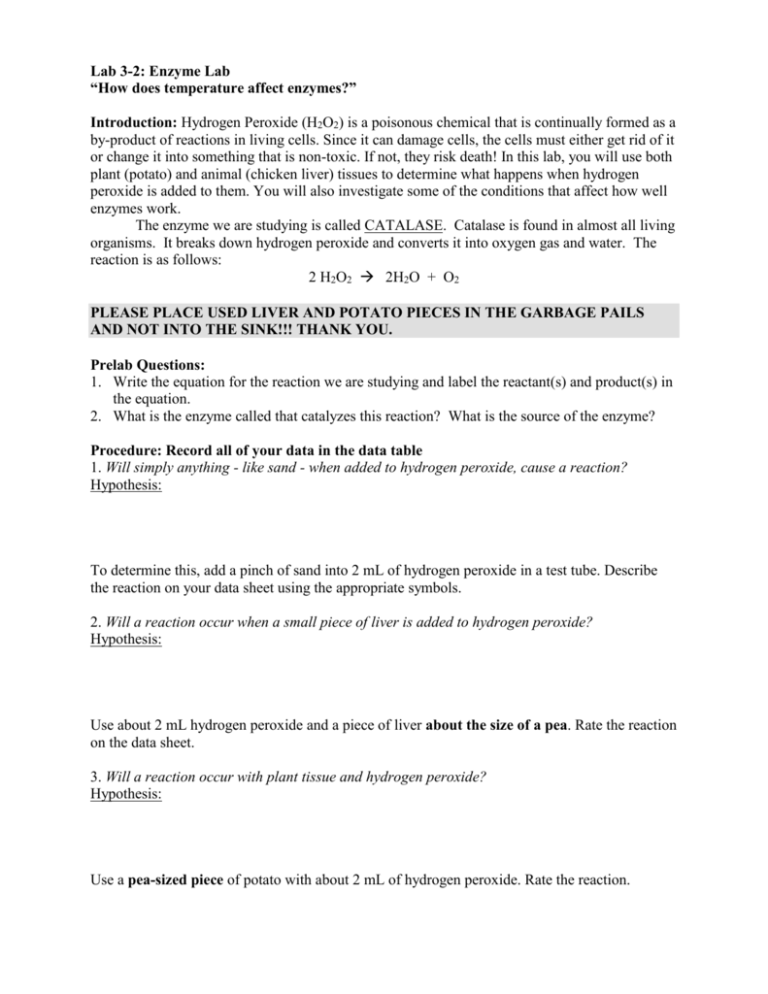
Lab 3-2: Enzyme Lab “How does temperature affect enzymes?” Introduction: Hydrogen Peroxide (H2O2) is a poisonous chemical that is continually formed as a by-product of reactions in living cells. Since it can damage cells, the cells must either get rid of it or change it into something that is non-toxic. If not, they risk death! In this lab, you will use both plant (potato) and animal (chicken liver) tissues to determine what happens when hydrogen peroxide is added to them. You will also investigate some of the conditions that affect how well enzymes work. The enzyme we are studying is called CATALASE. Catalase is found in almost all living organisms. It breaks down hydrogen peroxide and converts it into oxygen gas and water. The reaction is as follows: 2 H2O2 2H2O + O2 PLEASE PLACE USED LIVER AND POTATO PIECES IN THE GARBAGE PAILS AND NOT INTO THE SINK!!! THANK YOU. Prelab Questions: 1. Write the equation for the reaction we are studying and label the reactant(s) and product(s) in the equation. 2. What is the enzyme called that catalyzes this reaction? What is the source of the enzyme? Procedure: Record all of your data in the data table 1. Will simply anything - like sand - when added to hydrogen peroxide, cause a reaction? Hypothesis: To determine this, add a pinch of sand into 2 mL of hydrogen peroxide in a test tube. Describe the reaction on your data sheet using the appropriate symbols. 2. Will a reaction occur when a small piece of liver is added to hydrogen peroxide? Hypothesis: Use about 2 mL hydrogen peroxide and a piece of liver about the size of a pea. Rate the reaction on the data sheet. 3. Will a reaction occur with plant tissue and hydrogen peroxide? Hypothesis: Use a pea-sized piece of potato with about 2 mL of hydrogen peroxide. Rate the reaction. 4. The reaction in procedure #2 occurs for a time and finally stops. Does it stop because hydrogen peroxide is changed or because the liver was changed? Hypothesis: Figure out with your lab partners how to establish whether it is the liver that gets changed in the reaction or the hydrogen peroxide that gets changed. Hint: Can either the liver or hydrogen peroxide be reused in subsequent reactions? Describe your test for this step (your test will probably involve two test tubes): 5. Does temperature have any effect on the rate of the reaction? Hypothesis: Crush the liver (about the size of a pea) before doing this step. Place your liver in boiling water, room temperature water, and ice water for 5 minutes, and then add hydrogen peroxide to each. Results – Use the following key to rate the reaction ++++ : most vigorous reaction +++ : vigorous reaction + : slight reaction - : no reaction STEP 1 2 3 4 4 5 5 5 MATERIAL ADDED Sand + hydrogen peroxide Liver + hydrogen peroxide Potato + hydrogen peroxide used liver + new hydrogen peroxide used hydrogen peroxide + fresh liver ground liver ground potato boiled liver room temp liver chilled liver acidic liver (pH = 1 ) liver + water (pH = 6 ) basic liver (pH =8 ) ++ : some reaction GROUP DATA CLASS DATA Analysis Questions: 1. What is an enzyme? What enzyme did we use in this lab, and what is its substrate? In what kinds of living tissue is this enzyme found? 2. What gas was in the bubbles we observed? 3. Explain why the data you collected was qualitative. HONORS: Propose one way that you could collect quantitative data. Explain why the data you proposed is quantitative. 4. Would the hydrogen peroxide have broken down without an enzyme present? Explain. 5. Do enzymes get used up? Use data as evidence here! 6. Why does grinding up the liver or potato increase enzyme concentration? 7. Is the speed of an enzyme-catalyzed reaction affected by concentration of the enzyme? Use data as evidence! Why does increasing the concentration of the enzyme do this? Be as specific as possible. 8. Is the speed of an enzyme-catalyzed reaction affected by temperature? Use data as evidence! 9. How does temperature affect the way an enzyme works? Be as specific as possible and use key vocab words. 10. Is the speed of an enzyme-catalyzed reaction affected by pH? Use data as evidence! 11. For YOUR experiment in step #5, what was the independent variable? What was the dependent variable? 12. List each of the control groups (there are 5 of them) and write a sentence for each explaining why we had to perform each particular control. In other words – what did we learn by doing each control group.





